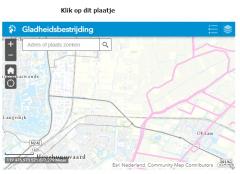Gladness Control
In winter, roads are sometimes slippery due to freezing, sleet or snow. We want to keep our roads and cycle paths as safe as possible during this period. To this end we cooperate with Rijkswaterstaat, which gritters the roads for us. HHNK is also commissioned by Rijkswaterstaat to grit certain roads managed by municipalities. Conversely, there are also some HHNK roads where municipalities control the icing.

If you click on the image to the right you will see which roads are gritted on behalf of the Water Board. You can search by municipality and even by the name of the road.
Recreational bike paths and cul-de-sacs are not gritted.
Three work districts
Because we manage a large area, we use three working districts for gritting, each with its own support point: one in Hoorn, one in Oostzaan and one in the Beemster. This enables us to grit all roads within 2.5 hours. In cooperation with the field coordinators and Meteogroep, the head coordinator of HHNK keeps an eye on day and night when gritting is required. The implementation is in the hands of Rijkswaterstaat.
Differences in approach
The various road authorities are responsible for ice control on the roads under their management. Each organization has a different approach. HHNK, the state and the province, for example, use wet salt spreaders to grit the roads preventively. Some municipalities grit preventively, others only grit when it gets slippery. The decision whether or not to grit can also vary from one agency to another. We can decide to grit certain parts of our area and not certain parts. So, as a road user, you should always be careful: even though there is a gritting service, the road can still be slippery.
If you have any questions about smoothness control, please contact us at 072 582 8282 or this question form.